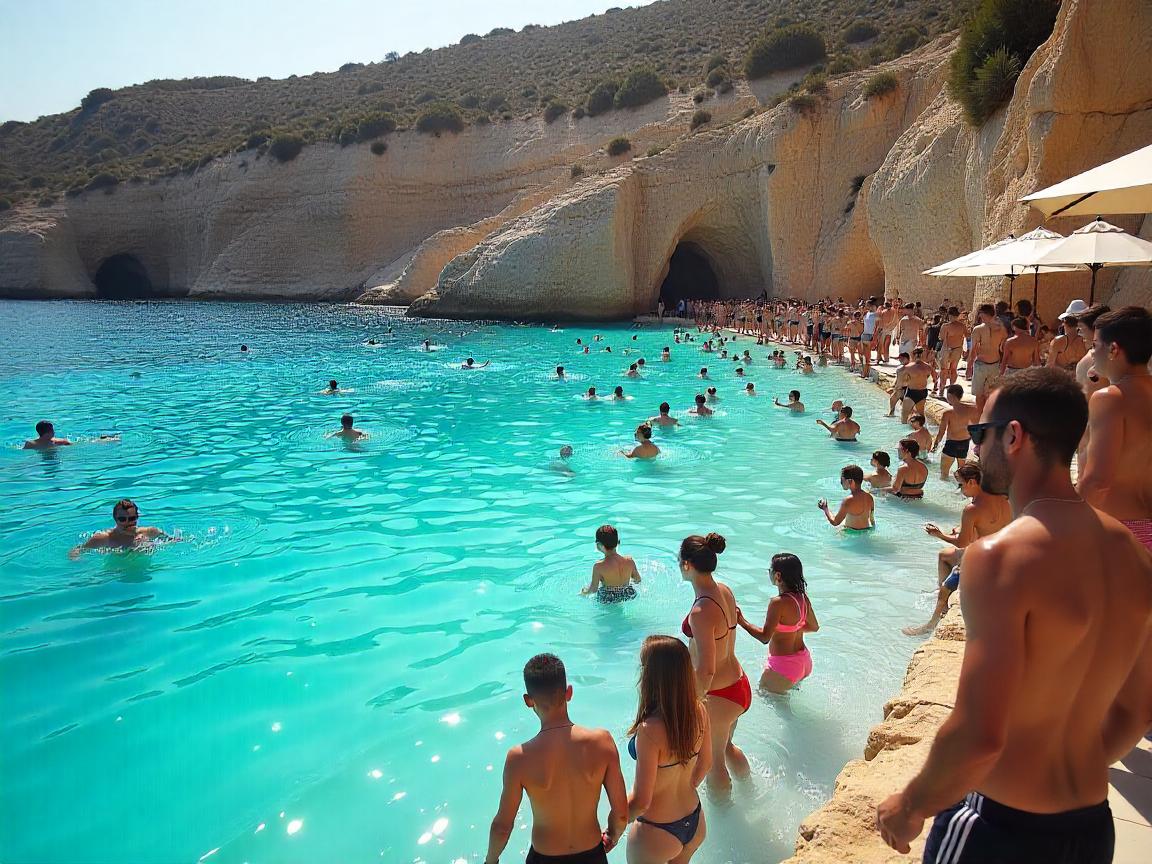Friday, June 27, 2025
Comino Island, a small gem in the Mediterranean, is widely known for its crystal-clear waters and picturesque landscapes. However, as tourism continues to surge, this once peaceful haven is becoming overwhelmed. With 10,000 visitors arriving daily during the peak summer months, the island is struggling to handle the influx, leading to environmental concerns. The rapid rise of Comino Island tourism has led to overcrowding and triggered the Maltese government to introduce measures to preserve the island’s natural beauty for the future.
A Rising Tide of Tourists: The Strain on Comino Island
Comino Island, located between Malta’s main island and the island of Gozo, is home to the famous Blue Lagoon Comino, a natural pool surrounded by breathtaking cliffs and pristine waters. Despite its small size, this 1.4-square-mile island has become a top destination for visitors from around the world. In 2024, Malta welcomed nearly 3.6 million tourists, and the numbers continue to climb. Comino, in particular, has witnessed a sharp increase in visitors, putting immense pressure on the island’s infrastructure and its environment.
The consequences of overcrowded tourist destinations are becoming more apparent. Reports indicate that during peak summer months, as many as 10,000 tourists descend on Comino daily, causing severe crowding at the Blue Lagoon Comino and other popular spots. Local residents have expressed concern, pointing out that the current level of tourism is unsustainable.
The Government’s Response: Introducing Capacity Limits for Sustainable Tourism
In response to the growing pressure, Malta’s Tourism Minister, Ian Borg, has announced measures to address the issue of overtourism on Comino Island. In February, Borg revealed plans to impose a capacity cap on the island, limiting the number of tourists allowed to visit each day. The goal is to reduce overcrowding, protect the island’s fragile ecosystem, and ensure that Comino Island tourism remains sustainable for the future.
Minister Borg explained that the current situation—where commercial boat operators unload hundreds of tourists at once—is simply too much for the small island to bear. His proposed solution aims to cut the number of visitors by half during the peak season, which will help ease the strain on the island’s resources and environment.
Why This Move is Crucial for Comino and Malta’s Future
The preservation of Comino’s environment goes beyond maintaining its beauty for visitors; it is also about protecting its vital ecosystems. The island is home to significant natural sites, including the Natura 2000 marine protected area and an Important Bird Area (IBA), where 50 to 80 breeding pairs of the Yelkouan shearwater—a seabird species—find refuge. The tourism impact Comino is experiencing, with the increasing number of visitors, threatens these sensitive habitats, potentially disturbing wildlife and damaging the environment.
By imposing a capacity limit, Malta’s government seeks to protect these vital areas while ensuring the long-term health of Comino’s environment. This initiative aligns with the broader goals of promoting sustainable tourism Malta, where the economic benefits of tourism are balanced with environmental responsibility.
Tourism Experts Weigh In: Sustainable Solutions for Overcrowding
Tourism industry experts have praised the Maltese government’s decision to limit the number of tourists visiting Comino Island. Eammon Turley, CEO of MPV Rentals, supports the capacity cap as an essential move to preserve the island’s natural charm and safeguard its environment. Turley notes that while Comino remains a popular destination due to its beauty, the environmental consequences of mass tourism cannot be ignored. He points to the destruction of bird habitats, the influx of rodents from discarded food, and the deterioration of the island’s shores and waters as tangible effects of overcrowding.
Turley further emphasizes the importance of balancing the economic benefits of Malta tourism with sustainability. He argues that reducing visitor numbers won’t discourage tourists—in fact, it will enhance their experience, allowing them to enjoy the island in a more peaceful and meaningful way. By promoting tourism to different parts of Malta, such as lesser-known areas on the main island and Gozo, the strain on Comino can be alleviated, benefiting both visitors and local communities.
Encouraging a Broader Tourism Experience: Alternatives to Comino
While Comino’s Blue Lagoon remains a top attraction, Malta is home to many other stunning locations that offer quieter and more relaxing experiences. Alexandra Dubakova, a travel expert, suggests that tourists explore other areas of Malta to reduce pressure on popular sites. For example, Zejtun, one of Malta’s oldest towns, remains relatively untouched by mass tourism due to its inland location. These lesser-known spots provide a more authentic Maltese experience and offer visitors a chance to discover the island beyond its typical tourist routes.
Additionally, Malta’s neighboring island, Gozo, boasts a variety of scenic bays and tranquil walks that are far less crowded than Comino. By encouraging tourists to explore these alternatives, Malta can distribute the flow of visitors more evenly, which will help reduce the environmental strain on Comino and other popular destinations.
Looking Ahead: Sustainable Tourism for the Future of Malta
The future of Comino Island tourism hinges on how effectively the government can balance tourism with conservation efforts. The proposed capacity limits and the promotion of alternative destinations are key to achieving a sustainable tourism model in Malta. As overtourism continues to affect destinations worldwide, Malta’s approach may serve as an example for other regions grappling with similar issues.
By prioritizing sustainability and responsible travel, Malta is working to ensure the continued prosperity of both its tourism industry and its natural heritage. Through thoughtful management, Comino can retain its beauty while offering visitors a memorable and environmentally responsible experience.
Conclusion: A Call for Sustainable Practices in Tourism
With Comino Island tourism reaching unsustainable levels, the Maltese government is taking important steps to preserve this beloved island. By limiting visitor numbers and promoting alternative destinations, Malta is moving toward more sustainable tourism practices. This careful balance between environmental protection and economic growth will help ensure that Comino remains a pristine destination for future generations to enjoy.
